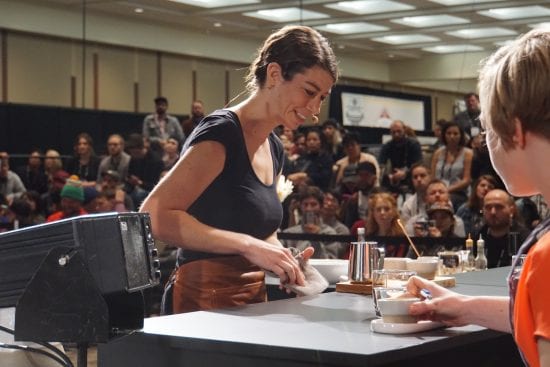
The top six competitors at last month’s United States Barista Championship crafted some diverse—and tasty—signature drinks. We talked to the competitors, who shared the inspiration behind their drinks and how to make them at home.
BY ASHLEY RODRIGUEZ AND CHRIS RYAN
BARISTA MAGAZINE ONLINE
Photos by Nate Gwatney.
Each of the top six competitors at last month’s United States Barista Championship had to craft a signature drink for the judges. The signature drink is meant to be an expression of the barista’s skill, understanding of their coffee, and their creativity. Below, we talk to the top three finishers about how they came up with their drinks and the recipes they used so you can recreate these top-finishing drinks. You can read about the fourth- through sixth-place finishers here.

Talya Strader, Equator Coffees & Teas
What inspired your signature drink?
For a good portion of competition prep, we really wanted for the signature beverage to feel like champagne, as we were calling the Finca Sophia Gesha the champagne of coffees. Luxurious was to be the theme throughout—as this coffee was like expensive comfort.

What’s the recipe?
– Adhere a 50/50 blend of dehydrated strawberry/raspberry finely ground to the sticky part of the flute (to mimic the red fruit note, give a kiss of sparkling acidity, and create an appealing presentation and engaging aromatics)

Andrea Allen, Onyx Coffee Lab
What inspired your signature drink?
I’m always inspired by complexity and simplicity. My coffee underwent a lactic acid process, and I wanted to play with lactic acidity in another ingredient to put with my coffee. I also love a play on milk and espresso. I clarified milk, which is essentially putting citric acid (lime juice) with milk, which separates the solids and the clear liquid of the milk. The clear liquid ends up tasting like creamy limeade. This process was so simple to do, composed of simple ingredients, and easy to understand (plus yummy!).
What coffee did you use and why did you choose it?
I used a lactic washed green tip Gesha from my friends Felipe Sardi and Elisa Madrinan from their beautiful farm La Palma y El Tucan in Colombia. I chose this coffee because it cupped the best of any coffee I tasted in preparation for competition. I got the chance to go to Colombia last fall and taste tons of coffee with the hopes of finding one to use in competition. It is one of the best coffees I’ve ever tasted. I like to compete with coffees from producers I have relationships with—the entire chain of coffee hinges on relationships.
What did you hope to accomplish with your signature drink?
I wanted to serve something that was delicious, simple, had depth of complexity, and showcased my coffee well. Competition signature drinks are so tricky because they have to be extremely espresso-forward. I’ve personally had many renditions of sig drinks that “met the criteria” but did not taste good. I wanted to make sure that my judges had a pleasant, fun experience with my drink. I also wanted aroma to play a huge role in the drink. Smell has such strong connection with memory. I wanted to offer my judges more than just a taste experience. I used rose water to wash the judges’ hands as a symbol of the humble service that I’ve experienced from producers and which I believe that leaders in the coffee industry should be passing forward to our staff and peers and on to our customers. I wanted my signature drink to embody all of those things: service, aroma, beautiful coffee, complexity, simplicity.

What’s the recipe?
84g La Palma Gesha Espresso (19.5g in, 42g out, extracted at 17 seconds. Yep, it’s a gusher)
25g clarified milk
6 dashes of rose water
2 dashes acid phosphate,
6 grams Terroir coffee blossom honey simple syrup
Rose water hand wash. Served at room temperature.

Kyle Ramage, Mahlkonig USA
What inspired your signature drink?
I named my drink “From Durham with Love,” and it was inspired by the coffee’s Ethiopia-like flavors—floral and bitter like hops, sweet like honey. I wanted to change the acidity around a little, so I added tartaric acid, which transformed the flavors quite a bit.
What coffee did you use and why did you choose it?
I used Finca Nuguo honey and natural process Gesha from western Panama. It is truly one of the most stunning coffees I have ever tasted. I also have a personal connection with [Nuguo manager] Jose [Gallardo] and Lem Butler (my coach and 2017 U.S. Barista Champion).
What did you hope to accomplish with your signature drink?
I wanted to express the coffee’s amazing flavors but transform them into something else at the same time. Technology and process.

What’s the recipe?
60ml honey process Nuguo
35ml of Mosaic hop tea
12ml dark honey simple syrup
30ml tartaric acid solution
Charged in a frozen whipped cream charger with nitrous.
Served in small beer snifters.

